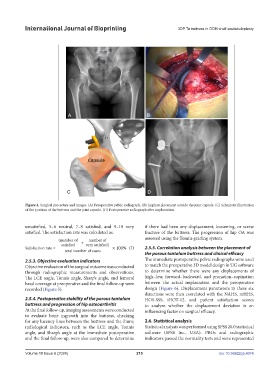Page 223 - IJB-10-6
P. 223
International Journal of Bioprinting 3DP Ta buttress in DDH shelf acetabuloplasty
Figure 4. Surgical procedure and images. (A) Preoperative pelvic radiograph. (B) Implant placement outside the joint capsule. (C) Schematic illustration
of the position of the buttress and the joint capsule. (D) Postoperative radiograph after implantation.
unsatisfied, 5–6 neutral, 7–8 satisfied, and 9–10 very if there had been any displacement, loosening, or screw
satisfied. The satisfaction rate was calculated as: fracture of the buttress. The progression of hip OA was
(number of number of assessed using the Tonnis grading system.
satisfied + very satisfied)
Satisfaction rate = × 100% (I) 2.5.5. Correlation analysis between the placement of
total number of cases
the porous tantalum buttress and clinical efficacy
2.5.3. Objective evaluation indicators The immediate postoperative pelvic radiographs were used
Objective evaluation of the surgical outcome was conducted to match the preoperative 3D model design in UG software
through radiographic measurements and observations. to determine whether there were any displacements of
The LCE angle, Tonnis angle, Sharp’s angle, and femoral high–low, forward–backward, and pronation–supination
head coverage at preoperative and the final follow-up were between the actual implantation and the preoperative
recorded (Figure 5). design (Figure 6). Displacement parameters in these six
directions were then correlated with the NAHS, mHHS,
2.5.4. Postoperative stability of the porous tantalum HOS-SSS, iHOT-12, and patient satisfaction scores
buttress and progression of hip osteoarthritis to analyze whether the displacement deviation is an
At the final follow-up, imaging assessments were conducted influencing factor on surgical efficacy.
to evaluate bone ingrowth into the buttress, checking
for any lucency lines between the buttress and the ilium; 2.6. Statistical analysis
radiological indicators, such as the LCE angle, Tonnis Statistical analysis was performed using SPSS 20.0 statistical
angle, and Sharp’s angle at the immediate postoperative software (SPSS Inc., USA). PROs and radiographic
and the final follow-up, were also compared to determine indicators passed the normality tests and were represented
Volume 10 Issue 6 (2024) 215 doi: 10.36922/ijb.4074

